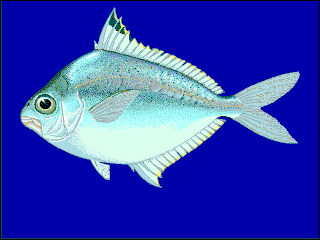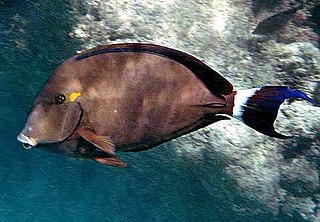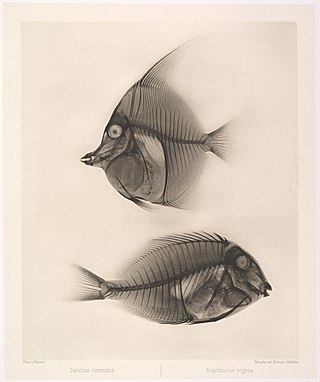
Rabbitfishes or spinefoots, genus Siganus, are perciform fishes in the family Siganidae. It is the only extant genus in its family and has 29 species. In some now obsolete classifications, the species having prominent face stripes—colloquially called foxfaces–are in the genus Lo. Other species, such as the masked spinefoot, show a reduced form of the stripe pattern. Rabbitfishes are native to shallow waters in the Indo-Pacific, but S. luridus and S. rivulatus have become established in the eastern Mediterranean via Lessepsian migration. They are commercially important food fish, and can be used in the preparation of dishes such as bagoong.

Leiognathidae, the ponyfishes, slipmouths or slimys / slimies, are a small family of fishes in the order Perciformes. They inhabit marine and brackish waters in the Indian and West Pacific Oceans. They can be used in the preparation of bagoong.

Pontinus is a genus of marine ray-finned fish belonging to the family Scorpaenidae, the scorpionfishes. The scorpionfishes in this genus are distributed in the tropical and warm temperate parts Atlantic, Indian and Pacific Oceans.

Platycephalus is a genus of mostly marine, demersal ray-finned fish belonging to the family Platycephalidae. They are found in the eastern Mediterranean, the Indian Ocean and western Pacific Ocean.

Acanthurus blochii, the ringtail surgeonfish or dark surgeonfish, is a marine ray-finned fish belonging to the family Acanthuridae, the surgeonfishes, unicornfishes and tangs. This fish is found in the Indo-Pacific.

Prionurus is a genus of marine ray-finned fishes belonging to the family Acanthuridae, the surgeonfishes, unicornfishes and tangs, although some of the species in this genus are called sawtails or doctorfish. The species in this genus are found in the Pacific Ocean with one species, P. biafraensis, found in the Atlantic Ocean.

Secutor is a genus of ponyfishes native to the Indian Ocean and the western Pacific Ocean.

Paracentropogon is a genus of ray-finned fishes, waspfishes belonging to the subfamily Tetraroginae, which is classified as part of the family Scorpaenidae, the scorpionfishes and their relatives, These fish are found in the Indian Ocean and western Pacific Ocean.

The striped ponyfish is a species of marine ray-finned fish, a ponyfish from the family Leiognathidae. It is native to the Indian Ocean and the western Pacific Ocean, from the Red Sea and the eastern coast of Africa to Fiji and Samoa, where it occurs in coastal marine and brackish waters. It occurs at depths of from 20 to 50 metres. It is a predator upon smaller fishes, small crustaceans and polychaete worms. This species grows to a length of 21 centimetres (8.3 in) TL though most do not exceed 17 centimetres (6.7 in) TL. It is of minor importance to local commercial fisheries. This species is the only known member of its genus.

Equulites is a genus of ponyfishes native to the Indian Ocean and the western Pacific Ocean. Analysis of mitochondrial DNA published in 2017 has suggested that Equulites elongates is in fact a species group made up of three species Equulites aethopos, Equulites elongates and Equulites popei.

Leiognathus is a genus of marine ray-finned fishes, ponyfishes from the family Leiognathidae. They are native to the Indian Ocean and the western Pacific Ocean. They are sometimes known as silverbellies.

Photopectoralis is a genus of marine ray-finned fishes, ponyfish from the family Leiognathidae. They are native to the Indian Ocean and the western Pacific Ocean.

Eubleekeria splendens, common names splendid ponyfish and blacktip ponyfish, is a species of ponyfish.

Leiognathus equula, the common ponyfish is a species of marine ray-finned fish, a ponyfish from the family Leiognathidae. It occurs in brackish and marine waters from East Africa to Fiji in the Indian and western Pacific Oceans, Red Sea and Persian Gulf.

Photolateralis stercorarius, the oblong slipmouth, is a marine ray-finned fish, a ponyfish from the family Leiognathidae. It has been recorded from Indonesia, Philippines, New Guinea, Guam and Tonga in the western Pacific Ocean. It lives on inner reef flats and in silt-laden inshore waters at depths greater than 20 metres (66 ft). It attains a maximum recorded total length of 10.2 centimetres (4.0 in). It was first formally described in 1907 as known as Leiognathus stercorarius by the American ichthyologists Barton Warren Evermann (1853-1932) and Alvin Seale (1871-1958) with the type locality given as Bulan, Sorsogon in the Philippines. It was more recently named as Equulites stercorarius, but was re-evaluated in 2015 as part of Photolateralis. It is the type species of the genus Photolateralis.

Photolateralis is a genus of marine ray-finned fishes, ponyfish from the family Leiognathidae. This genus is unique among ponyfishes in possessing a translucent mid-lateral flank stripe which, depending on the species, may be either a composite stripe of numerous independent translucent windows or a continuous translucent lateral stripe.

Leiognathus berbis, the Berber ponyfish, is a species of marine ray-finned fish, a ponyfish from the family Leiognathidae. It is found in brackish and marine waters in the Indian and Pacific Oceans from the Red Sea, Gulf of Aden and Zanzibar east in the Indian Ocean to south-east Asia. Like its relatives, the fish is a demersal species that feeds on small crustaceans and bivalves. Equula berbis is considered by some authorities to be nomen dubium with the taxon it is assigned to being of uncertain placement beyond the family level, the name being thought to probably be a junior synonym of Equulites oblongus.

Leiognathus brevirostris, commonly known as the shortnose ponyfish, is a fish of brackish and marine waters found from Indo-West Pacific to the Indian coasts and off Sri Lanka to China and south of Australia. Like its relatives, the fish is an amphidromous, demersal species which feeds on diatoms, copepods, Lucifer, nematodes and polychaetes. The fish has eight dorsal spines, sixteen dorsal soft rays, three anal spines and fourteen anal soft rays. Fresh specimens possess a golden gleam which fades with dryness.
Equulites klunzingeri, or Klunzinger's ponyfish, is a marine, demersal species of ponyfish from the family Leiognathidae which was originally found only in the Red Sea. It is colonizing the Mediterranean as part of the Lessepsian migration through the Suez Canal.

The grey-head surgeonfish is a species of marine ray-finned fish belonging to the family Acanthuridae which includes the surgeonfishes. unicornfishes and tangs. This species has a wide Indo-Pacific distribution.


















